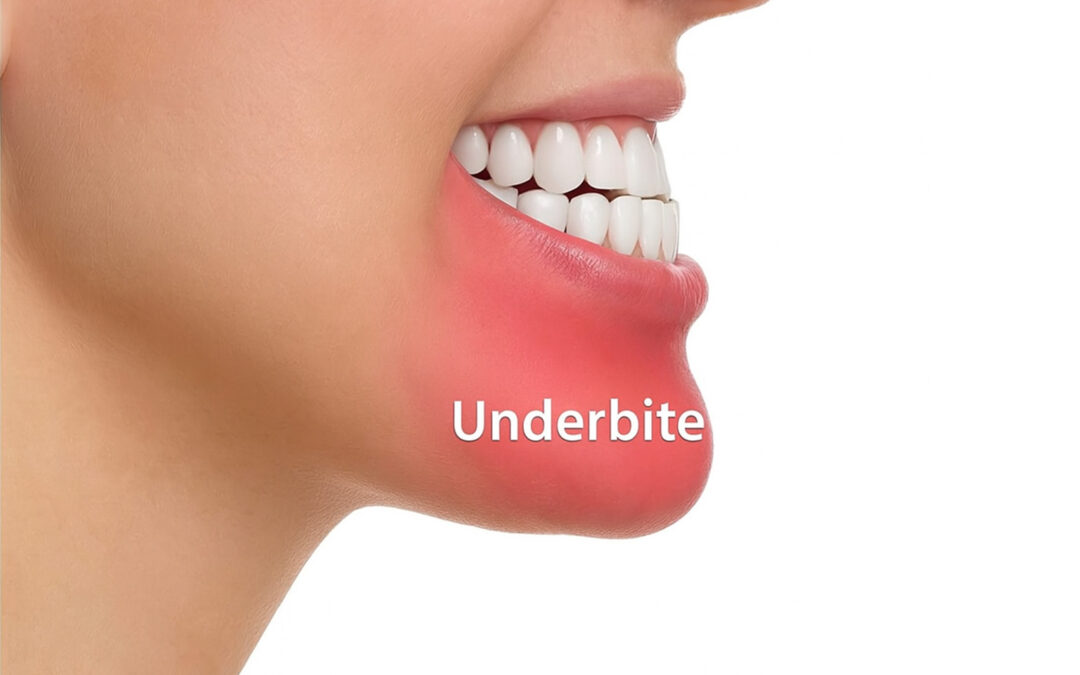What Is an Underbite?
An underbite can exert uneven pressure on the gums and bones, leading to gum recession and bone resorption. According to the American Academy of Periodontology, up to 36% of dental implant failures occur in areas affected by severe bite misalignment.
Patients who correct their underbite and adhere to regular periodontal maintenance have a significantly higher success rate for dental implants—over 90% in clinical studies.
The International Congress of Oral Implantologists (ICOI) Pisa Consensus Conference.
As a board-certified periodontist in Irvine, Orange County, CA, I have observed how bite issues like underbite not only affect dental alignment but also significantly impact the long-term health of your gums, bone, and dental implants.
Oral Health Problems Associated with an Underbite
An underbite is more than just a cosmetic issue. While some individuals may adapt to mild cases, severe underbites can lead to oral health complications, including:
- Difficulty in biting and chewing food properly due to jaw misalignment
- Speech issues
- Jaw and facial pain due to misalignment
- Developing gum disease and bone loss
Causes of an Underbite

An underbite can result from a variety of factors that affect the alignment of the jaw and teeth. Some common causes include:
Childhood Habits
Certain childhood habits can increase the risk of an underbite or other dental misalignments, such as:
- Thumb sucking
- Tongue thrusting
- Prolonged pacifier use beyond the age of three
- Extended bottle-feeding past infancy
Genetic Factors
In most cases, an underbite is hereditary. If at least one family member has this condition, the likelihood of developing it increases. Genetics also influence jaw shape, tooth size, and positioning.
Jaw Injuries
Severe facial trauma, such as accidents, can cause permanent jawbone damage. While broken jawbones can often be repaired, the jaws may not always realign correctly after surgery, leading to an underbite.
Tumors
Tumors in the jawbone or oral cavity can distort the normal alignment of the jaw and teeth. In such instances, addressing the underlying cause through surgery, followed by periodontal treatment, is essential to restoring function and aesthetic appearance.
Treatment for Underbite

Common Treatments for Underbite
Correcting a severe underbite is essential for both functional and aesthetic benefits, including:
- Easier oral hygiene maintenance
- Reduced risk of tooth decay and gum disease
- Less strain on teeth, jaw, and facial muscles (which helps prevent temporomandibular joint disorder (TMJ) and reduces the risk of tooth fractures)
- Gum recession is seen in 47% of patients with untreated severe underbite, which can severely limit the success of dental implants and other periodontal procedures.
At-Home Care
Brushing and flossing regularly, along with routine dental check-ups, are essential for maintaining healthy teeth. However, individuals with misaligned teeth or dental concerns need extra care to prevent further complications.
If you have an underbite, regular periodontal evaluation is necessary because bite forces can cause microtrauma to gum tissue that may not be obvious in routine dental exams.
Medical Treatment
The only way to permanently correct an underbite and achieve proper dental alignment is through medical intervention. These treatments can also improve the overall appearance of the teeth.
For mild cases of underbite (Class III malocclusion), a periodontist or orthodontist may recommend:
- Braces or clear aligners to reposition the teeth gradually
- Tooth extraction in the lower jaw if overcrowding contributes to the underbite
In patients with chronic gum disease, orthodontic or surgical treatment for underbite should be coordinated with periodontal therapy to prevent further bone loss. Studies show that combined approaches can improve gum health by 35% in complex cases.
Underbite Surgery
Most oral and maxillofacial surgeons can successfully perform orthognathic surgery (corrective jaw surgery) for underbites. Common surgical procedures include:
- Advancing the upper jaw forward
- Repositioning the lower jaw backward
- Combining jaw surgery with braces or retainers to maintain proper bone alignment
Patients with pre-existing gum disease have a 2.5 times higher risk of surgical complications and delayed healing after jaw surgery. A periodontist can help manage these risks with pre- and post-surgical care.
Conclusion
In summary, consulting a periodontist for an assessment of gum and bone health in underbite patients is critical. Studies show that combined orthodontic and periodontal treatments increase treatment success by up to 40% in complex cases.
Sources:
https://www.perio.org/for-patients/gum-disease-information/

